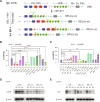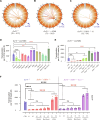ATM and 53BP1 regulate alternative end joining-mediated V(D)J recombination
- PMID: 39083600
- PMCID: PMC11290492
- DOI: 10.1126/sciadv.adn4682
ATM and 53BP1 regulate alternative end joining-mediated V(D)J recombination
Abstract
G0-G1 phase alternative end joining (A-EJ) is a recently defined mutagenic pathway characterized by resected deletion and translocation joints that are predominantly direct and are distinguished from A-EJ in cycling cells that rely much more on microhomology-mediated end joining (MMEJ). Using chemical and genetic approaches, we systematically evaluate potential A-EJ factors and DNA damage response (DDR) genes to support this mechanism by mapping the repair fates of RAG1/2-initiated double-strand breaks in the context of Igκ locus V-J recombination and chromosome translocation. Our findings highlight a polymerase theta-independent Parp1-XRCC1/LigIII axis as central A-EJ components, supported by 53BP1 in the context of an Ataxia-telangiectasia mutated (ATM)-activated DDR. Mechanistically, we demonstrate varied changes in short-range resection, MMEJ, and translocation, imposed by compromising specific DDR activities, which include polymerase alpha, Ataxia-telangiectasia and Rad3-related (ATR), DNA2, and Mre11. This study advances our understanding of DNA damage repair within the 53BP1 regulatory domain and the RAG1/2 postcleavage complex.
Figures








Similar articles
-
Senataxin and DNA-PKcs redundantly promote non-homologous end joining repair of DNA double strand breaks during V(D)J recombination.Sci Adv. 2025 Jun 20;11(25):eads5272. doi: 10.1126/sciadv.ads5272. Epub 2025 Jun 20. Sci Adv. 2025. PMID: 40540553 Free PMC article.
-
CtIP-mediated DNA resection is dispensable for IgH class switch recombination by alternative end-joining.Proc Natl Acad Sci U S A. 2020 Oct 13;117(41):25700-25711. doi: 10.1073/pnas.2010972117. Epub 2020 Sep 28. Proc Natl Acad Sci U S A. 2020. PMID: 32989150 Free PMC article.
-
ATM priming and end resection-coupled phosphorylation of MRE11 is important for fork protection and replication restart.Proc Natl Acad Sci U S A. 2025 Apr 22;122(16):e2422720122. doi: 10.1073/pnas.2422720122. Epub 2025 Apr 18. Proc Natl Acad Sci U S A. 2025. PMID: 40249789
-
APE1 is a master regulator of the ATR-/ATM-mediated DNA damage response.DNA Repair (Amst). 2024 Dec;144:103776. doi: 10.1016/j.dnarep.2024.103776. Epub 2024 Oct 19. DNA Repair (Amst). 2024. PMID: 39461278 Review.
-
ATM and p53 in aging and cancer: a double-edged sword in genomic integrity.Biogerontology. 2025 May 5;26(3):102. doi: 10.1007/s10522-025-10249-4. Biogerontology. 2025. PMID: 40323544 Review.
Cited by
-
Distinct functions of PAXX and MRI during chromosomal end joining.iScience. 2025 May 22;28(6):112722. doi: 10.1016/j.isci.2025.112722. eCollection 2025 Jun 20. iScience. 2025. PMID: 40546969 Free PMC article.
-
Senataxin and DNA-PKcs redundantly promote non-homologous end joining repair of DNA double strand breaks during V(D)J recombination.Sci Adv. 2025 Jun 20;11(25):eads5272. doi: 10.1126/sciadv.ads5272. Epub 2025 Jun 20. Sci Adv. 2025. PMID: 40540553 Free PMC article.
-
53BP1/RIF1 and DNA-PKcs show distinct genetic interactions with diverse chromosomal break repair outcomes.bioRxiv [Preprint]. 2025 May 11:2025.05.08.652920. doi: 10.1101/2025.05.08.652920. bioRxiv. 2025. PMID: 40654801 Free PMC article. Preprint.
References
-
- Schatz D. G., Ji Y., Recombination centres and the orchestration of V(D)J recombination. Nat. Rev. Immunol. 11, 251–263 (2011). - PubMed
-
- Liu Q., Palomero L., Moore J., Guix I., Espín R., Aytés A., Mao J.-H., Paulovich A. G., Whiteaker J. R., Ivey R. G., Iliakis G., Luo D., Chalmers A. J., Murnane J., Pujana M. A., Barcellos-Hoff M. H., Loss of TGFβ signaling increases alternative end-joining DNA repair that sensitizes to genotoxic therapies across cancer types. Sci. Transl. Med. 13, eabc4465 (2021). - PMC - PubMed
Publication types
MeSH terms
Substances
LinkOut - more resources
Full Text Sources
Molecular Biology Databases
Research Materials
Miscellaneous

